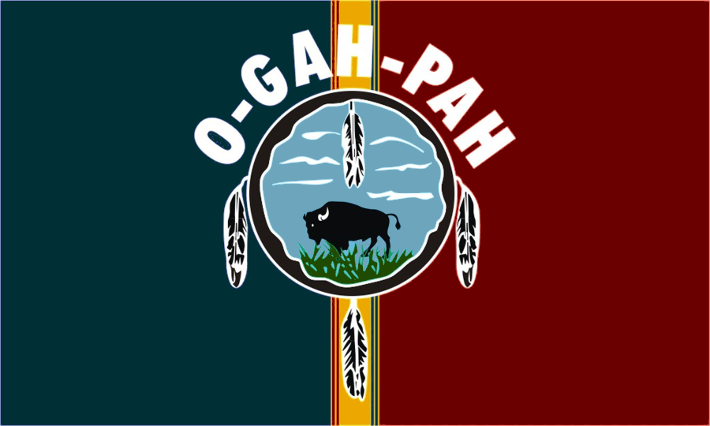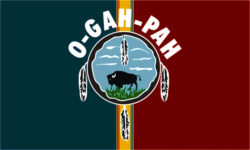Quapaw Tribe
The Quapaw Indians, whose four villages were located along the Arkansas River, were military allies and trade partners of colonial Louisianans.

Courtesy of Wikimedia Commons
Quapaw Nation Flag. Ozarks Razorback
The Quapaws, whose four villages were located along the Arkansas River, were military allies and trade partners of colonial Louisianans. They supplied and hosted numerous French explorers and travelers, and worked in tandem with the Arkansas Post, provisioning colonists and offering reconnaissance for the defense of the middle Mississippi Valley. The tribe hunted and fished in the Ouachita River basin in part of present-day northeastern Louisiana.
The Quapaws first appeared in historical accounts in 1673, when they encountered the first French explorers in the Mississippi Valley led by Father Jacques Marquette and Louis Joliet. The French referred to the Quapaws as the Arkansas, an Illini term meaning “people of the south wind”; Marquette and Joliet applied “Arkansas” to the Quapaw people as well as the river and the land it flowed through.
At that time, the Quapaws lived in four villages along the Mississippi River. They established one village, Kappa, on the east bank; two others, Tongigua and Tourima, were established on the west. A fourth, Osotouy, was located at the mouth of the Arkansas River. Villages included longhouses, which were occupied by several families and which surrounded the central plaza. A council house for the meetings of the village chief and elders was closest to the plaza. In marriage, the Quapaws were patrilineal and patrilocal, unlike many southern tribes. A Quapaw of one moiety—a division of clans within the tribe who linked themselves to either the earth or the sky—could not marry a person from the same moiety.
Quapaw population figures differ greatly in the late seventeenth century and in the eighteenth century. Estimates ranged from 3,500 to 7,500. From 1698 to the mid-eighteenth century, epidemics and raids by other tribes—the Chickasaws in particular—severely depopulated the Quapaws. By 1721 depopulation also led to the unification of the Tourima and Tongigua villages. By that time, all of the villages were located on the Arkansas River. At the time of the Louisiana Purchase, the Quapaw population stood at only 555, in three villages located on the south bank of the Arkansas River. The wave of Anglo-American immigration to Arkansas, while smaller than that occurring in Missouri and Louisiana, overwhelmed them.
Like other Native American tribes, the Quapaws divided labor along gender lines: women were farmers and gatherers, and men were hunters and warriors. Women farmed extensive fields of maize, squash, beans, sunflowers, and many other plants and vegetables. Men hunted the abundant wild game, primarily deer, bears, and, into the early nineteenth century, bison. Quapaw hunting territory extended along the Arkansas River past present-day Little Rock and within the Grand Prairie. Later in the eighteenth century, the Quapaws were hunting to the west and southwest into the Ouachita basin in what is present-day northwestern Louisiana.
They intermarried with the French, their strong allies during the colonial period. Quapaws fought with or supported the French in war and helped to defend the Mississippi River against the pro-British Chickasaws. Although France ceded their Louisiana colony, including Arkansas, to Spain in 1762, the Quapaws sustained close ties to the remaining French colonists and became allies of the new Spanish colonial government.
The Quapaws’ involvement in local and regional trade continued into the territorial period. Corn, grown by Quapaw women, and horses, raised by both men and women, were traded to the white neighbors as well as to hunters crossing the Mississippi River. Quapaw men also continued to hunt and to trade animal products.
As long as the Mississippi River marked a territorial boundary and travel on it could be contested, the Quapaws were important to colonial diplomacy and defense. The tribe was not as important an ally for the United States as it had been for the French and Spanish, however. Once the United States absorbed both banks of the Mississippi River with the Louisiana Purchase, the Quapaws no longer held a strategic position. Furthermore, as the US population grew, the economic role of the Quapaws diminished and their land became more desirable.
In an 1818 treaty the Quapaws agreed to a reservation of one million acres running northeast to southwest between the Arkansas and Ouachita Rivers. They relinquished their claims to thirty million acres south and west of the Arkansas. This region, however, was not enough for settlers and territorial officials, who coveted valuable Quapaw land on the Arkansas River. These groups put pressure on the Quapaws, who signed another treaty in 1824, ceding their reservation to the United States. In return they received land among the Caddo on the Red River in northwestern Louisiana, $4,000 in goods, and a $2,000 annual annuity for eleven years. The treaty also reserved land along the Arkansas River for eleven mixed-blood families.
In early 1826, the Quapaws’ move to Caddo country was met with disaster. Neither the Caddos nor their federal agent were informed of the move. Bureaucratic confusion about the tribe’s annuity further undermined the effort to successfully settle the Quapaws. Then floods destroyed the next harvest and starvation killed sixty people. After six months on Caddo land, one-fourth of the Quapaw tribe returned to the Arkansas River.
By 1830 all of the Quapaws had returned to Arkansas. Their chiefs pleaded with federal and territorial officials to allow the Quapaws to remain in Arkansas. In 1832 the Quapaws finally received annuity payments that had been denied to them for years. It was too little and too late. With their situation becoming more desperate, the Quapaws signed the treaty of 1833, by which they agreed to move to 150 acres in the northeastern corner of the Indian Territory (present-day Oklahoma). Many did not go to the new reservation. Instead, three hundred Quapaws returned to the Red River, where the annuity had mistakenly been sent. They eventually joined Chief Heckaton and 161 Quapaws who had started the process of rebuilding their nation in the Indian Territory.
Today, most of the Quapaw Nation resides in northeastern Oklahoma, with the tribal headquarters in Quapaw, Oklahoma.
